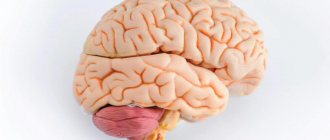Airways
The airways are a system of cavities through which air moves from the external environment into the lungs. Gas exchange does not occur in the airways themselves: it occurs only in the lungs. The airways include: the nasal cavity, pharynx, larynx, trachea and bronchi. We will study their structure and functions in this article.
Nasal cavity
The beginning of the respiratory tract, the air channel in which the olfactory organs are located. During inhalation, air enters the nasal cavity through the nostrils - paired anterior openings, passing through the nasal passages, and exits into the pharyngeal cavity (nasopharynx) through the choanae.
The nasal cavity is covered with ciliated epithelium with cilia, which help clean the air from dust particles. There are a large number of microbes in the inhaled air, so they are constantly neutralized in the nasal cavity by leukocytes that migrate from the capillaries into the nasal cavity, where bacteria phagocytize.
The olfactory organ is located in the upper part of the nasal cavity, with the help of which a person distinguishes odors. The walls of the nasal cavity are intertwined with a dense network of capillaries, thanks to which the incoming air is warmed. The mucus secreted in the nasal cavity helps to humidify the air.
As a result, moistened, warmed and purified air moves through the choanae into the pharynx and reaches the larynx.
Larynx
The larynx is not only an airway, but also a vocal apparatus. The wall of the larynx is formed by cartilages: in front - the epiglottis, thyroid and cricoid cartilages, in the back are the remaining 3 pairs of cartilages.
The larynx contains vocal cords, consisting of elastic fibers of connective tissue. The glottis is located between the ligaments, the vibration of which during exhalation produces sound.
During normal breathing (with silence), the glottis is wide and triangular in shape. When speaking, the glottis narrows and the vocal cords begin to vibrate. Such changes are associated with the work of the muscles of the larynx, which, when contracting, change the position of the cartilage, as a result the position of the vocal cords and the width of the glottis changes.
Not only the larynx, but also the cheeks, lips, tongue, soft palate and paranasal sinuses are involved in the formation of articulate speech. During puberty, under the influence of hormones in men, the vocal cords thicken, which leads to a decrease in the timbre of the voice: the voice changes (mutates - from the Latin mutatio - change).
During puberty, boys develop a protrusion on the front of their neck - the Adam's apple. This occurs due to thickening of the thyroid cartilage, which is caused by the action of sex hormones.
I draw your special attention to the epiglottis, which closes the entrance to the larynx during swallowing. If this did not happen, then food particles would enter the respiratory system, causing a severe cough. Each of us, probably, during a conversation while eating, felt the oversight of such a conversation and began to choke and cough.
Now you understand that it makes no sense to blame the epiglottis for what happened. It can be in two positions: either close the entrance to the larynx (when we eat) or open (during a conversation). If we want everything at once, then the epiglottis is not responsible here! 
Trachea
Below the larynx is the trachea - a tube 15-20 cm long, consisting of cartilaginous half-rings. The esophagus is adjacent to the trachea. The mucous membrane of the trachea performs a protective function due to the presence of lymphoid tissue, and the mucus covering the walls of the trachea moisturizes the air passing through it.
The ciliated epithelium covers the wall of the trachea and performs the same function as in the nasal cavity: it cleans the air of dust particles. By the beating of the cilia, these foreign particles are directed back to the exit from the respiratory tract.
The trachea is divided into two main bronchi: right and left, heading to the lungs of the same name.
Bronchi
The right and left main bronchi enter the corresponding lungs, where they branch repeatedly. Anatomically, the right bronchus is shorter and wider than the left, so foreign bodies are more likely to enter the right bronchus. The wall of the bronchi partly resembles the wall of the trachea: it contains cartilaginous rings (in the trachea - half rings) that prevent the bronchi from collapsing.
The main bronchi are divided into lobar bronchi, which are divided into segmental bronchi, and the segmental bronchi are divided into small bronchioles another 10-15 times. As a result, a branched bronchial tree is formed.
The bronchi branch many times, but, of course, at some point the branching stops. The bronchi end in terminal respiratory bronchioles, the walls of which are devoid of cartilage. The structural and functional unit of the lung, the acinus, begins with these respiratory bronchioles.
From the respiratory bronchioles begin the alveolar ducts with sacs, on the walls of which the alveoli are located. Alveolus (from Latin alveolus - cell) is a bubble-shaped structure that makes up the respiratory sections of the lung and is involved in breathing. In total, there are about 300 million alveoli in the lungs, and their total surface reaches 140 m2 - approximately 70 times the area of the human body.
Almost the entire surface of the alveoli is occupied by alveolocytes of the first order (type 1) - respiratory alveolocytes. It is through their membrane that gas exchange occurs between alveolar air and blood.
Alveolocytes of the second order (type 2) secrete surfactant, a surface-active substance necessary for the normal function of the alveoli. The surfactant prevents the alveoli from collapsing and drying out; in addition, the surfactant is involved in the formation of the air-hematic barrier.
Diseases
Laryngitis (from ancient Greek λάρυγξ - larynx) is inflammation of the mucous membranes of the larynx and vocal cords.
Chronic laryngitis - a disease of teachers, announcers, singers - develops in those who, due to the nature of their work, are forced to overstrain their vocal cords for a long time. It is accompanied by a sore throat, cough, the voice may weaken until it disappears completely, and sometimes there is difficulty breathing.
© Bellevich Yuri Sergeevich 2018-2021
This article was written by Yuri Sergeevich Bellevich and is his intellectual property. Copying, distribution (including by copying to other sites and resources on the Internet) or any other use of information and objects without the prior consent of the copyright holder is punishable by law. To obtain article materials and permission to use them, please contact Yuri Bellevich
.
Everyone knows how important breathing is for maintaining the vital functions of the body. But few people think about how even a slight disruption of normal nasal breathing can affect the condition of various human organ systems.
Various anomalies of the upper respiratory tract, diseases not detected in a timely manner and not treated (adenoids, sinusitis, rhinitis, deviated nasal septum, etc.), as well as a number of other reasons, can lead to the development of pathological changes in the nasal mucosa that are difficult to eliminate or cannot be eliminated at all, to disruption of normal nasal breathing, which subsequently contributes to the occurrence of diseases of various body systems.
Due to difficulty in nasal breathing, a “transition” to breathing through the mouth occurs. Such people usually sleep with their mouths open, their sleep is restless, intermittent and often accompanied by snoring. No matter how long they sleep, patients with impaired nasal breathing constantly complain that they do not get enough sleep, so they usually look lethargic and apathetic. For this reason, schoolchildren and students often experience a decrease in academic performance, weakening memory and attention; adults experience a decrease in performance and become irritable.
In the nose, the inhaled air is purified, moistened, and warmed. When breathing through the mouth, unpurified (this is in our environmental situation!!!), dry and cold air enters the lungs, which inevitably entails diseases of the lungs and bronchi.
Such patients often complain of headaches, as a result of obstructed outflow of blood and lymph from the brain; this condition is explained by congestion in the nasal cavity.
The most dangerous thing is “improper breathing” for a growing organism. Constant breathing through the mouth leads to deformation of the facial skeleton. Such children often develop malocclusion. As a result of prolonged difficult nasal breathing, the chest is deformed. Ventilation of the lungs is disrupted, blood oxygen saturation decreases, the number of red blood cells and hemoglobin content decreases.
When breathing through the mouth, there is less resistance to air flow, as a result of which the development of positive and negative pressure in the chest cavity, necessary for the normal functioning of the heart, is suppressed.
Thus, impaired nasal breathing affects not only the respiratory organs directly, but can also lead to significant pathological changes throughout the body. When a person switches to breathing through the mouth, the entire functioning mechanism of various organs and systems is disrupted. The respiratory rhythm, blood flow and nutrition of the brain are disrupted, and as a result - deterioration of memory, thinking abilities, disruption of blood composition, functions of the cardiovascular system...









